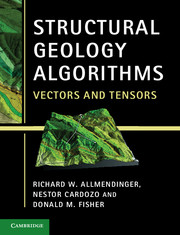Book contents
- Frontmatter
- Contents
- Preface
- Chapter One Problem solving in structural geology
- Chapter Two Coordinate systems, scalars, and vectors
- Chapter Three Transformations of coordinate axes and vectors
- Chapter Four Matrix operations and indicial notation
- Chapter Five Tensors
- Chapter Six Stress
- Chapter Seven Introduction to deformation
- Chapter Eight Infinitesimal strain
- Chapter Nine Finite strain
- Chapter Ten Progressive strain histories and kinematics
- Chapter Eleven Velocity description of deformation
- Chapter Twelve Error analysis
- References
- Index
Chapter Twelve - Error analysis
Published online by Cambridge University Press: 05 June 2012
- Frontmatter
- Contents
- Preface
- Chapter One Problem solving in structural geology
- Chapter Two Coordinate systems, scalars, and vectors
- Chapter Three Transformations of coordinate axes and vectors
- Chapter Four Matrix operations and indicial notation
- Chapter Five Tensors
- Chapter Six Stress
- Chapter Seven Introduction to deformation
- Chapter Eight Infinitesimal strain
- Chapter Nine Finite strain
- Chapter Ten Progressive strain histories and kinematics
- Chapter Eleven Velocity description of deformation
- Chapter Twelve Error analysis
- References
- Index
Summary
Introduction
Structural geologists have a love–hate relationship with uncertainty. Ask any one of us how much uncertainty is associated with a single strike and dip measurement and we will readily admit that natural surfaces are highly irregular at various scales and so there are probably “a few degrees” slop in our measurements. Because one can collect only a relatively small number of measurements per day in the field, we certainly aren’t going to repeat a single bedding measurement 20 or more times just to get “good statistics” at a single location! Nonetheless, when we calculate a mean vector of a bunch of, say, paleocurrent directions (Chapter 2) or a best-fit fold axis (Chapter 5), we routinely calculate and report the confidence intervals, or rather more likely a computer program written by someone else calculates them for us. If you have read this far in the book, however, you now know how to calculate them for yourself! Two recent trends brought on by the digital age are forcing structural geologists to reexamine their relationship with uncertainty.
First, the availability of large digital data sets and their incorporation into routine geological studies have exploded in the last couple of decades. We have access to digital elevation models sampled on a 30 m grid, GoogleEarth imagery with a resolution of less than 5 m, GPS data sets with thousands of individual stations, and nearly instant access to hundreds or thousands of aftershocks that follow a large earthquake. These data sets allow us to analyze vastly more data than previously; the era of collecting just 30 or 40 measurements in the field per day is long gone. The digital data can be analyzed quantitatively and that means taking into account uncertainties.
- Type
- Chapter
- Information
- Structural Geology AlgorithmsVectors and Tensors, pp. 254 - 280Publisher: Cambridge University PressPrint publication year: 2011



